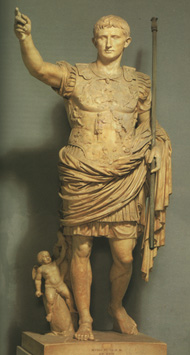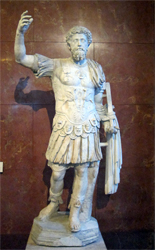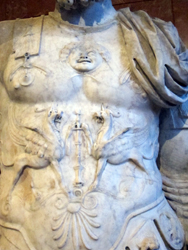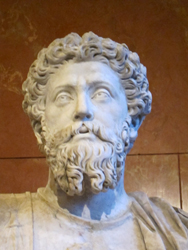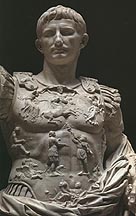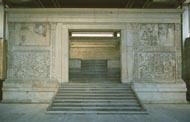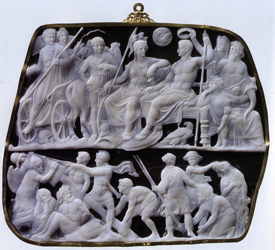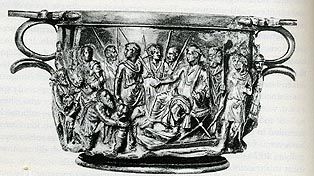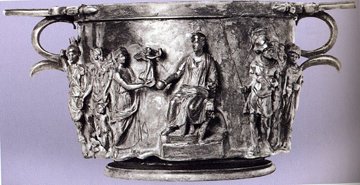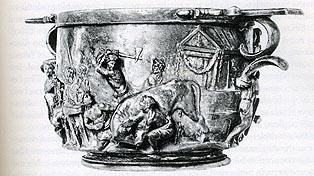Art Home | ARTH Courses | ARTH 200 Assignments
Roman Power and Roman Imperial Sculpture
Power is very rarely limited to the pure exercise of brute force....Power is ...a far more complex and mysterious quality than any apparently simple manifestation of it would appear. It is as much a matter of impression, of theatre, of persuading those over whom authority is wielded to collude in their subjugation. Insofar as power is a matter of presentation, its cultural currency in antiquity (and still today) was the creation, manipulation, and display of images. In the propagation of the imperial office, at any rate, art was power (Jas Elsner, Imperial Rome and Christian Triumph, Oxford, 1998, p. 53). Through visual imagery a new mythology of Rome and, for the emperor, a new ritual of power were created. Built on relatively simple foundations, the myth perpetuated itself and transcended the realities of everyday life to project onto future generations the impression that they lived in the best of all possible worlds in the best of all times....At the same time as his "restoration of the Republic" and the creation of his new political style, Augustus, also set in motion a program to "heal" Roman society. The principal themes were renewal of religion and custom, virtus, and the honor of the Roman people. Never before had a new ruler implemented such a far-reaching cultural program, so effectively embodied in visual imagery; and it has seldom happened since (Paul Zanker, The Power of Images and the Age of Augustus (1990). |
Roman power was constructed and made manifest in its marble monuments. Emperors from the pagan Roman empire of Augustus to the Christian empire of Constantine and Theodosius were aware of the important role architectural and sculptural monuments played in establishing their power. A coherent language of art reflecting the different functions of the Emperor was developed to express this authority. This begins with Octavianus who would subsequently become Augustus Caesar, the first Roman Emperor.
When Octavianus had defeated his rivals at the battle of Actium in 31 BCE to end the civil wars that had marked the last 100 years of the Roman Republic, he was very deliberate in articulating his power. He wanted to avoid the error of Julius Caesar who had taken dictatorial control of Rome and earned the great resentment of the Roman Senate which had been the traditional center of power. Octavianus carefully constructed himself as a renovator rather than innovator. He fostered Roman tradition. In 28/7 BCE he formally surrendered his supremacy and restored the government to the Senate and People. Augustus describes this in his Res Gestae:
| In my sixth and seventh consulships [28/7 BCE], after I had stamped out the civil wars and at a time when by universal consent I was in absolute control of everything. I transferred the res publica from my own charge ('ex mea potestate') to the discretion of the Senate and the People of Rome. For this service I was given the name "Augustus" by a decree of the Senate. |
To avoid the resentment of the Roman Senate, Octavianus now Augustus thus wanted to avoid institutionalized authoritarian power. He characterized himself as Princeps or "the First Citizen." From this comes the term Principate that identified the theory of power of the early Empire. Augustus also called himself Pater Patriae, "father of the country." Augustus maintained his authority by taking over traditional positions of authority. He became imperator or the general of the Roman army. This gave him control of the vast flung provinces that had fallen under Roman control. In Rome itself his authority was based on taking on one of the two consulships. In 12 BCE, Augustus took on the position of Pontifex maximus or the chief priest. By exploiting traditional positions of power Augustus was able to characterize himself as "the restorer of the Res publica," and perserver of traditional Roman customs. As Pontifex maximus, Augustus demonstrated his pietas, or respect and duty to traditional customs. Augustus also used his wealth and patronage to foster his authority and that of Rome. It was under Augustus that Vergil wrote the great national and religious epic poem the Aeneid, Horace composed his odes, and Livy wrote his history of Rome. In passages like Jupiter's famous prophecy to Venus in the first book of the Aeneid the destiny of Rome to rule a vast empire are laid out. These themes are clearly echoed in the visual arts commissioned by Augustus.
The Augustus of Primaporta
In the first book of the Aeneid, Vergil compares Neptune calming a raging sea caused by the vengeful Juno to a statesman who commands the masses by his authority or auctoritas. This passage unmistakeably echoes Augustus's account of his accession to power from his Res Gestae quoted above. This passage presents a literary equivalent to the famous Augustus of Primaporta:
| Just as often happens when in a great nation turmoil breaks out and the base masses go on a rampage: firebrands and stones fly, and madness supplies the weapons: then, if they have caught sight of some man who carries weight because of his public devotion and service, they stand silent, their ears ready to listen. Then he prevails in speech over their fury by his authority, and placates them. Just so, the whole uproar of the sea died down, when the father of the seas looked upon the waters. The sky cleared, Neptune turned his horses around, and flying onward, gave free rein to his compliant chariot (I.148-156) |

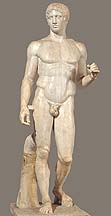 The
so-called Augustus
of Primaporta was clearly made to provide visible testament to Augustus's
claim to authority and the creation of a visual language of imperial
images. Augustus holds in his left hand a spear which was a symbol of ability in arms and power (imperii). The spear, which will morph into the scepter of the medieval king, was a regular symbol of imperial power. Augustus is shown wearing the cuirass, or breastplate of a military
general. This manifests Augustus's role as imperator, or head
of Rome's military forces. The
formula of the cuirass statue would be one of the most prevalent in the
Roman tradition. For example see Harvard's Arthur M. Sackler Museum statue
of the
Emperor Trajan.
A coin from the reign of Valens in the middle of the fourth century exemplifies
the continuity of this formula. Along with the cuirass, a common characteristic
of this portrait type is the contrapposto pose with the weight clearly
shifted to one leg. Scholars have seen a special reference in this pose
in the statue of Augustus. They have seen strong parallels to the statue
entitled the Doryphoros by the Greek mid fifth-century BCE artist
Polykleitos. This statue was one of the most famous and most copied statues
of Antiquity. A copy in Naples gives us some sense of the lost original.
Literary references to this
statue make it clear that Polykleitos intended this statue to be a visual
demonstration of his canon of ideal man. The similarities between the
two statues extend beyond the poses to the handling of facial details.
Both emphasize the clear delineation of the brow and nose. Similar conventions
are used in the handling of the hair of both. It was undoubtedly intentional
on the part of the Augustan artists to base their statue on the Greek
work. The rich drapery with its multiple-folds and elegant edge can be
related to Greek Classical drapery style like that appearing on the Parthenon.
Both the Doryphoros and
the Augustus
of Primaporta share
the same calm, self-controiled expression. Using the Greek distinction,
both represent the ethos, or character, of the figures rather
than their pathos, or immediate emotional response. The conception
of the ideal man of the Greek Classical period was an important
model
for Augustus,
the
ideal
man of
his age,
but there
is the significant difference that the Augustus statue is unmistakably
a portrait of Augustus while the Doryphoros like the other major
Greek works is a representation of the archetypal concept of the male
figure and clearly not a representation of a particular individual.
The
so-called Augustus
of Primaporta was clearly made to provide visible testament to Augustus's
claim to authority and the creation of a visual language of imperial
images. Augustus holds in his left hand a spear which was a symbol of ability in arms and power (imperii). The spear, which will morph into the scepter of the medieval king, was a regular symbol of imperial power. Augustus is shown wearing the cuirass, or breastplate of a military
general. This manifests Augustus's role as imperator, or head
of Rome's military forces. The
formula of the cuirass statue would be one of the most prevalent in the
Roman tradition. For example see Harvard's Arthur M. Sackler Museum statue
of the
Emperor Trajan.
A coin from the reign of Valens in the middle of the fourth century exemplifies
the continuity of this formula. Along with the cuirass, a common characteristic
of this portrait type is the contrapposto pose with the weight clearly
shifted to one leg. Scholars have seen a special reference in this pose
in the statue of Augustus. They have seen strong parallels to the statue
entitled the Doryphoros by the Greek mid fifth-century BCE artist
Polykleitos. This statue was one of the most famous and most copied statues
of Antiquity. A copy in Naples gives us some sense of the lost original.
Literary references to this
statue make it clear that Polykleitos intended this statue to be a visual
demonstration of his canon of ideal man. The similarities between the
two statues extend beyond the poses to the handling of facial details.
Both emphasize the clear delineation of the brow and nose. Similar conventions
are used in the handling of the hair of both. It was undoubtedly intentional
on the part of the Augustan artists to base their statue on the Greek
work. The rich drapery with its multiple-folds and elegant edge can be
related to Greek Classical drapery style like that appearing on the Parthenon.
Both the Doryphoros and
the Augustus
of Primaporta share
the same calm, self-controiled expression. Using the Greek distinction,
both represent the ethos, or character, of the figures rather
than their pathos, or immediate emotional response. The conception
of the ideal man of the Greek Classical period was an important
model
for Augustus,
the
ideal
man of
his age,
but there
is the significant difference that the Augustus statue is unmistakably
a portrait of Augustus while the Doryphoros like the other major
Greek works is a representation of the archetypal concept of the male
figure and clearly not a representation of a particular individual.
Beyond the standardization of type, a striking feature of the Augustus statue and imperial portraiture in general is the standardization in the representation of the individual emperors. While the portraits of Augustus are easily identifiable by the facial features, the artists were clearly not interested in representing Augustus at different stages of his life. Portraits of Augustus are not 'realistic' at all and bear little resemblance to the description of him given by Suetonius (Augustus 79-82). There are no portraits of a sixty year old Augustus. Like the Augustus of Primaporta, the portraits show Augustus at the prime of his life.
Another significant difference between the Polykleitos statue and the Augustus of Primaporta is how the Doryphoros is self-contained in its balanced pose while the right arm of the Augustus of Primaporta extends out in space. This is one of the most popular and easily identifiable gestures in Roman art, the ad locutio gesture or the gesture of speech. In Roman public life, the orator played a central role. The ability to convince an audience through an effective oration was critical to the success of a politician. For a military leader, the ability to rally and motivate the army was a hallmark of a great general. The ad locutio gesture conveys of the voice and authority of the figure.
The importance of the orator in Roman public life explains the central role of rhetoric in Roman education. A good rhetorician would learn to adapt his style to the appropriate context. A good rhetorician would know to use a simpler, plainer style for certain audiences while using a higher, more eloquent style in more formal and sophisticated contexts. He also would know how to quote respected authorities to lend support to an argument. There is thus an important parallel between rhetoric and the design of Augustan statuary. It was clearly intentional to adapt the Classical Greek style and specific reference to the famed statue by Polykleitos in creating the Augustus of Primaporta. What scholars call Augustan classicism relates the period of Augustus to the great period of Greek culture of the fifth century BCE, the so-called age of Pericles and the period of the Parthenon.
Individual details of the statue serve to reinforce the claims and ambitions of Augustus. Attached to the right foot of Augustus and serving as a support for the statue is a representation of a cupid riding on the back of a dolphin. As stated in the prophesy from the Aeneid cited above, Augustus traced his ancestry back to Aeneas and the foundation of the Roman tradition. Aeneas was understood to have been the off-spring of the goddess Venus like the Cupid who rides the back of the dolphin. This geneaology was central to his claim to be princeps and pater patriae. Patriarchal family structure was the bedrock of Roman society. The Roman elite of the Senatorial class owed their status not to their personal accomplishments but to the authority of their family. By basing his claim to authority on his geneaology which links him to the first family of Rome, Augustus was appealing to traditional Roman values. He again constructed himself as a conserver and rennovator and definitely not as an innovator.
The decoration of the cuirass places a specific event in the context of a Roman vision of the world. At the center of the relief, there is a barbarian figure clearly identifiable by pants and beard handing a Roman military standard to a man dressed on a Roman cuirass. While there is no certainty as to the identification of the Roman in the scene, the barbarian is identifiable as a Parthian, perhaps their king Phraates IV, who returned the Roman standards in 20 BCE that the Parthians had captured in 53 BCE after the defeat of Crassus. Significantly this victory was a diplomatic and not a military one, and was heralded as an important step in establishing the era of Augustan peace. Other figures on this cuirass bring out the universal implications of this event. At the top appears a bearded figure holding a veil over his head. This is Caelus, or the Sky god, with the mantle of the heavens. Beneath this figure appears a figure driving a four-horse chariot. This is the sun-god Sol. The chariot is preceded and appears to chase a figure identified as Aurora. Flanking the central group are again two female figures. The one on the left has been identified as Hispania (Spain) while the other has been suggested to be Gallia. Beneath these figures are the brother and sister pair of Apollo, with a lyre and riding a griffin, and Diana, riding a stag. At the very bottom of the cuirass appears the reclining female figure Tellus who holds a cornucopia and is accompanied by two babies. This imagery gives Roman rule divine sanction to rule everything under the heavens from Spain to Gaul and everything over the Earth. It is important to acknowledge the gender politics of this cuirass with the male Sol driving out female Aurora. The provinces and earth are personfied as female with the active male figures at the center of the composition. The imagery of the cuirass clearly relates to one of the odes of Horace.
While the Augustus of Primaporta gives visual form to the role of Augustus as imperator, or the leader of Roman military forces, other statues represent the other functions of Augustus. The statue above with its elaborate toga, the traditional Roman dress, and mantle drawn over the head (capite velato) identifies this statue as Augustus in the role of Pontifex maximus. The right arm which has been lost beneath the elbow originally held a patera or a sacrificial cup. A statue like this reminds us of the important role the practice of Roman religion played in the social and political life of Rome. In participating in the civic cults one signified their membership in Roman society. A central virtue in Roman society was pietas. It is important to distinguish this from the Christian ideas of piety. The Roman notion of Pietas focused on the maintenance and veneration of traditional Roman customs. By emphasizing his pietas, Augustus was again asserting his claim to be a conserver of traditional Roman values. It was not by chance that Vergil in his Aeneid repeatedly identifies the hero as "pious Aeneas." Again this makes the connection between Augustus and his legendary ancestor.
| On my return from Spain and Gaul in the consulship of Tiberius Nero and Publius Quintilius [13 B.C.E.] after successfully arranging affairs in those provinces, the senate resolved that an altar of the Augustan Peace should be consecrated next to the Campus Martius in honor of my return, and ordered that the magistrates and priests and Vestal Virgins should perform an annual sacrifice there....By new laws passed on my proposal I brought back into use many exemplary practices of our ancestors which were disappearing in our time, and in many ways I myself transmitted exemplary practices to posterity for their imitation (Acts of the Divine Augustus (2.2; 8.5). |
The most famous example of Augustan art that has come down to us is the Ara Pacis, or the Altar of Peace. Founded on July 4, 13 BCE and completed on January 30, 9 BCE, was designed as a permanent monument to the most important accomplishment of Augustus --the bringing of an era of peace. This was particularly important to the Romans who had witnessed the instability of the Civil Wars that marked the end of the Republican period. Augustan peace extended throughout the Roman / civilized world. The theme of peace is intertwined on the altar with themes of the dynastic claims of the family of Augustus, his social policy, and the importance of religion as a civilizing force.
The form of the altar is a large precinct wall that encloses the altar itself. Doors in the middle of the east and west sides provide access to the altar. Attempts to identify the source for the form of the altar have suggested close parallels to the fifth century BCE Altar of the Twelve Gods in the Agora in Athens. This is one of the many links connecting this Roman work to Greek and especially Athenian mid-fifth century monuments.
Rectangular figurative panels flank the doorways at either end of the exterior wall. The scenes on either side of the west end show the legendary founders of Rome. The left hand panel is poorly preserved. It represents Mars and the twin Romulus and Remus. Mars as the war god articulates the role war plays in the establishing of peace. Mars was understood to be the father of Romulus, the founder of Rome. As stated in the prophesy from the Aeneid, Romulus was understood to be an ancestor of Augustus.
The relief on the southwestern side represents another important ancestor of Augustus with the image of Aeneas Sacrificing. He is shown making an offering to the penates, or the household gods. Aeneas is accompanied by his son Julus-Ascanius. The implications of this panel for Augustus are very clear. Augustus would have wanted to be linked to his legendary ancestor Aeneas, the pater (father) of the Julian family and the Roman tradition. Aeneas' pietas testifies to his respect for his family traditions just as the altar testifies to the pietas of Augustus. The filial piety of Aeneas was a well-known subject in Roman art as demonstrated by its appearance in frescos, tombstones, and even lamps. The illustrated tombstone exemplifies this subject. Aeneas is shown as the "sandwich generation" supporting his father, Anchises, by his left arm and holding his son's hand by his right hand. The group illustrates Aeneas rescuing his father and son from burning Troy. The tombstone relief shows Aeneas wearing a cuirass like Augustus wears in the Augustus of Primaporta. Anchises is shown holding a box containing the penates or the family gods. It is to these penates that Aeneas is shown offering the sacrifice of the sow in the Ara Pacis relief. The sow is a reference to a prophesy in Virgil's Aeneid that the hero would find a sow under an oak tree when he arrived in Latium. The two panels on the west side of the altar, seen together, allude to two dominant functions of Augustus: as imperator (leader of army=Mars) and pontifex maximus (chief priest=Aeneas).
The reliefs on the east end of the building are allegorical figures. On the southeast side is the so-called Tellus panel. This is the personification of Earth. The figure is sometimes identified as Italia, or Italy. The two children in her lap along with the animals and plants allude to the bounty of earth, especially in an era of peace. She is flanked by female figures with billowing mantles that can be identified as sea and land breezes.
The panel on the northeast side is very fragmentary. Its subject was the seated figure of Roma with arms at her feet and accompanied by two figures who have been identified as the personifications of Honos (Honor) and Virtus (Virtue). It is significant to note the links between the two north panels on the east and west ends as focusing on military and war while the southern panels reflect more peaceful pursuits.
The four panels connect to four major themes of Augustan ideology: Piety and respect for traditional custom (Aeneas sacrificing); War ( Mars with Romulus and Remus); Victory (Roma with Honos and Virtus); Fruits of Peace (Tellus panel with the fertility of the land and sea).
 |
 |
The most
famous reliefs included on the altar are the two processional reliefs that
appear in the upper register of the north and south sides of the altar. The south frieze shows Augustus, attendants, and members of the family of
Augustus. Although the lower part of the figure is poorly preserved, enough
of the head is intact to enable an identification of the figure of Augustus.
He is shown in the toga with mantle over the head associated with a priest
in a sacrifice. His outstretched right arm suggests that he might have been
holding a patera. The figure echoes the representation of Augustus
as Pontifex Maximus and the figure of Aeneas sacrificing from the west
end.
The south frieze shows Augustus, attendants, and members of the family of
Augustus. Although the lower part of the figure is poorly preserved, enough
of the head is intact to enable an identification of the figure of Augustus.
He is shown in the toga with mantle over the head associated with a priest
in a sacrifice. His outstretched right arm suggests that he might have been
holding a patera. The figure echoes the representation of Augustus
as Pontifex Maximus and the figure of Aeneas sacrificing from the west
end.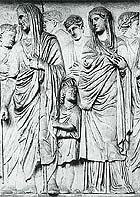 In about the center of the south frieze appears the son-in-law of Augustus,
Marcus Agrippa, the likely successor of Augustus. The inclusion of Agrippa
in the frieze has enabled scholars to date the events shown. Since Agrippa
died in 12 BCE, this must be the foundation ceremony that took place on July
4, 13 BCE. The figures on the north frieze have been identified as prominent
members of the Senate and families.
In about the center of the south frieze appears the son-in-law of Augustus,
Marcus Agrippa, the likely successor of Augustus. The inclusion of Agrippa
in the frieze has enabled scholars to date the events shown. Since Agrippa
died in 12 BCE, this must be the foundation ceremony that took place on July
4, 13 BCE. The figures on the north frieze have been identified as prominent
members of the Senate and families.
Scholars have long noted the parallels between the processional scenes from the Ara Pacis and the Ionic frieze from the Parthenon showing the Panathenaic Procession. The use of a continuous frieze showing a religious procession as well as the strong classicism of the Ara Pacis relief indicate some of the similarities between the two. But significant difference exists as well. Most notably is the approach to the subject matter. In the case of the Panathenaic frieze no individual procession can be identified. None of the mortals represented can be connected to known historical figures. While the Ara Pacis frieze, with its identifiable portraits can be identified as the foundation procession of July 4, 13 BCE. There is thus the contrast between the archetypal approach of Greek and what can be identified as the factual approach of the Roman work.
A striking difference between the two can be seen in the choice of types of figures included. In the Parthenon frieze, except for the group of maidens shown in a section of eastern frieze, there are no other mortal women included in the Parthenon frieze. Likewise there are no children included in the earlier frieze. In contrast, the Ara Pacis friezes intermingle male and female as well as children and adults. This intermingling of figures suggests the theme of family. The emphasis on family in the Ara Pacis relief echoes the important role families played in the social and political life of Rome. Ones identity was determined in significant ways by the identity of your family. The inclusion of members of the imperial family in particular can be related to Augustus's dynastic claim for his family. The family of Augustus which was understood to descend from the founders of the Roman tradition Aeneas and Romulus could claim the rightful position as the first family of Rome and rulers of Rome. The selection also can be seen to reflect Augustan social policy. Laws enacted by Augustus reflect a relaxing of restrictions on marriage and provided incentives for procreation.
Other Images of Augustus
|
Gemma Augustea, c. 10 A.D. In the upper register, Augustus along with Roma are enthroned. Augustus holds in his left hand the staff signifying his imperial power while in his right hand he holds the lituus, the curved scepter of an Augur (soothsayer). The semi-nudity of Augustus with the eagle beneath him indicates that Augustus is being presented in the guise of Jupiter. Capricorn, Augustus's zodiacal sign, appears between Augustus and Roma. To the left appears a youth probably identifiable as Germanicus and on the far left Tiberius steps down from a chariot driven by Victoria (Nike). On the far right appear Neptune and probably Italia or Tellus who holds a cornucopia. Behind them appears the figure of Oecumene, the personification of universal empire, who crowns Augustus with a crown of oak leaves (corona civica). In the lower register appear Roman soldiers raising a trophy to mark a victory over the barbarians. |
|
Boscoreale Cup 1: Augustus receiving the surrender of barbarians. Augustus's open hand signifies his clemency. (Compare the iconography of these cups to that of the panels of Marcus Aurelius. Also notice how this image has unmistakeable similarities to later images of the Adoration of the Magi in Christian art.) |
Boscoreale Cup 1: Augustus as world ruler: Augustus sits on a curule chair, the symbol of Roman magistracy. He holds a globe in his hand and receives a Nike figure from Venus who is followed by the infant figure of Amor or Cupid, the goddess Roma, and the Genus Populi Romani. To his left appears Mars leading a group of personifications representing the seven provinces. |
